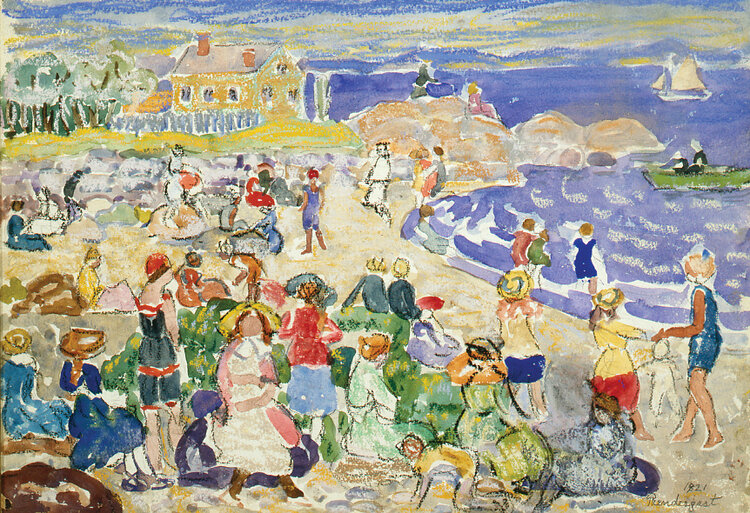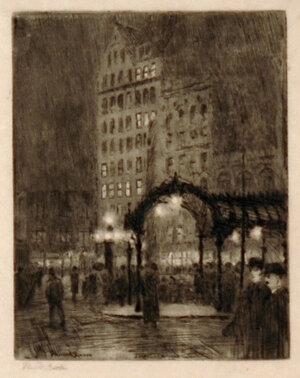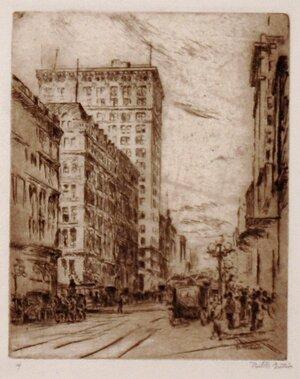Collection Connection is a series of personal responses by Museum staff to works in the Frye Art Museum’s collection.

Maurice Prendergast. Beach Scene, Marblehead, 1921. Watercolor, pastel, gouache, and pencil on paper. 14 ½ x 21 ½ in. Frye Art Museum, Museum Purchase, 1954.004.
Recently, I was lying in bed, streaming the Pacific Northwest Ballet’s entrancing selections of solo and “socially distanced” choreography in Rep 1, when I found myself arrested by a foreign sound: applause. The nine short performances were each followed by resounding (recorded) clapping, so I heard it over and over again. Each time, my ear became more attentive, as if the applause were its own production, defined by the variations in cadence and crescendos, faint whistles and composed cheers. Even though I knew that in reality the dancers had performed to a cavernous room of empty seats, I fantasized something that would have seemed so mundane one year ago: a room full of strangers, responding together to a moment shared in both time and space.
“How long will this muscle memory endure—the part of us that’s wary of any kind of bodily proximity, that’s wary of our own bodies and the bodies of others as vectors?” Essayist Leslie Jamison posed this question as she lamented her last trip to the Turkish Baths, in New York’s East Village, before the pandemic—a sentiment that applies to so many experiences that were once beloved but now raise feelings of unease, and even fear. It brought to mind how I now flinch at images of strangers lingering beside one another. My instincts have become so primed that even the past looks like a place that requires social distance. Irrespective of the context, everything from concert photographs to Renoir’s Luncheon of the Boating Party have brought on the same sensation: waves of recoil that are followed by a desperate longing for those casual exchanges, uninhibited by worry or fear or an immediate desire to move away.
In the Frye’s collection, several works evoke that sense of simultaneous attraction and repulsion for me these days. Maurice Prendergast’s Beach Scene, Marblehead (1921) is filled with an overabundance of the artist’s characteristic harmony—between color and composition, and also between anonymous figures, layered body-to-body and free of worry. Prendergast (American, born Canada, 1858-1924) was known for portraying crowds with each individual engaged in a specific activity that contributes to the work’s synchronized sensibility. Usually I try to lounge on Alki Beach as much as I can in the summer, reading and listening to kids’ squeals of delight and snippets of teenage gossip that carry over the Puget Sound’s quiet waves. This year, I went only once, situating myself so far from anyone else that the only voices I heard were the forlorn calls of seagulls. Even though I have often gone to the beach alone, it never felt like a lonely experience because I had a sense of my own self within the context of a collective moment—I felt like I was one among many, having an experience together. Even though there were other people at Alki this time, the towels separated by wide swaths of sand felt more like islands, disconnected and unmoored from the easy togetherness that permeates Prendergast’s beach.

Etching. 9 13/16 x 7 5/16 in. Frye Art Museum,
Gift of Mrs. Paul Morgan Gustin, 2004.011.07.
Who are all of the strangers we would have connected with during these days instead spent isolated? I think about this question often. It’s one made more prescient by Paul Morgan Gustin’s (American, 1886-1974) downtown Seattle etchings, which showcase the artist’s technique of wiping his inked plates to create softened lines and an atmospheric effect. As we move into our region’s rainy days, these gauzy scenes drive home the way the seasons feel as though they are passing me by, while most of my relationships and other parts of my life stay stagnant. The figures clustered beneath the Pioneer Square’s iconic iron pergola beg the question of who I might have encountered in the places I no longer frequent—bus stops, city parks, downtown streets. These etchings also vividly contextualize our present state against the moments in history they capture: Seattle’s downtown core flooded with people as the city increased its cable and street car lines in the late nineteenth and early twentieth centuries. It’s hard to reconcile the way corridors that had been busy for over 100 years are now filled with so much stillness; and yet, from here, months into the pandemic, the historic crowds suddenly look so strange within the context of our new normal.

1912. Etching. 9 13/16 x 8 7/16 in. Frye Art
Museum, Gift of
Mrs. Paul Morgan Gustin, 2004.011.06.
But all of this longing for chance encounters and collective experiences makes their unexpected appearance feel like something to savor unlike ever before. I realized this sitting beside my bedroom window, while on a phone call with a stranger. Part of 600 Highway Men’s performance series A Thousand Ways, hosted by On the Boards, we didn’t know each other’s names or where we lived. But, much like the affect of being stranded somewhere temporarily beside a stranger, while waiting for a late bus or inside a stopped train, we talked about an assortment of things that sometimes felt small, like postures and room details—and some that sounded larger, like families and former selves. At the call’s end, we parted ways, knowing we’d likely never reconnect. But in those moments, art created a new kind of chance encounter that made our existence “alone together” briefly much less alone.
A Thousand Ways continues at On the Boards into 2021. Visit their website for more information and tickets.
Visit Pacific Northwest Ballet’s website for more information an tickets to their digital season.
Erin Langner
Exhibitions and Publications Coordinator